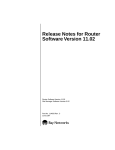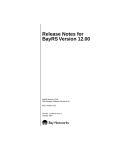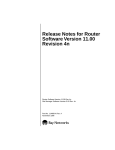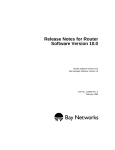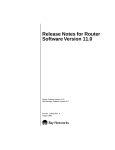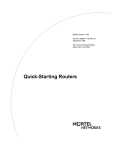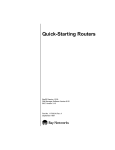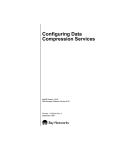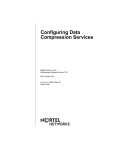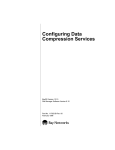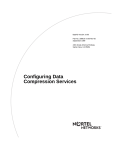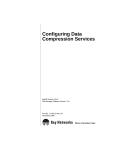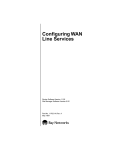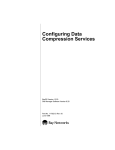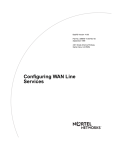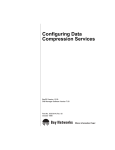Download Avaya Router Software 11.01 Release Notes
Transcript
Release Notes for Router Software Version 11.01 Router Software Version 11.01 Site Manager Software Version 5.01 Part No. 114093 Rev. B February 1997 4401 Great America Parkway Santa Clara, CA 95054 8 Federal Street Billerica, MA 01821 Copyright © 1988–1997 Bay Networks, Inc. All rights reserved. Printed in the USA. February 1997. The information in this document is subject to change without notice. The statements, configurations, technical data, and recommendations in this document are believed to be accurate and reliable, but are presented without express or implied warranty. Users must take full responsibility for their applications of any products specified in this document. The information in this document is proprietary to Bay Networks, Inc. The software described in this document is furnished under a license agreement and may only be used in accordance with the terms of that license. A summary of the Software License is included in this document. Restricted Rights Legend Use, duplication, or disclosure by the United States Government is subject to restrictions as set forth in subparagraph (c)(1)(ii) of the Rights in Technical Data and Computer Software clause at DFARS 252.227-7013. Notice for All Other Executive Agencies Notwithstanding any other license agreement that may pertain to, or accompany the delivery of, this computer software, the rights of the United States Government regarding its use, reproduction, and disclosure are as set forth in the Commercial Computer Software-Restricted Rights clause at FAR 52.227-19. Trademarks of Bay Networks, Inc. ACE, AFN, AN, BCN, BLN, BN, BNX, CN, FN, FRE, GAME, LN, Optivity, PPX, Bay Networks, SynOptics, SynOptics Communications, Wellfleet and the Wellfleet logo are registered trademarks and Advanced Remote Node, ANH, ARN, ASN, BayStack, Bay•SIS, BCNX, BLNX, EZ Install, EZ Internetwork, EZ LAN, PathMan, PhonePlus, Quick2Config, RouterMan, SPEX, Bay Networks Press, the Bay Networks logo and the SynOptics logo are trademarks of Bay Networks, Inc. Third-Party Trademarks All other trademarks and registered trademarks are the property of their respective owners. Statement of Conditions In the interest of improving internal design, operational function, and/or reliability, Bay Networks, Inc. reserves the right to make changes to the products described in this document without notice. Bay Networks, Inc. does not assume any liability that may occur due to the use or application of the product(s) or circuit layout(s) described herein. Portions of the code in this software product are Copyright © 1988, Regents of the University of California. All rights reserved. Redistribution and use in source and binary forms of such portions are permitted, provided that the above copyright notice and this paragraph are duplicated in all such forms and that any documentation, advertising materials, and other materials related to such distribution and use acknowledge that such portions of the software were developed by the University of California, Berkeley. The name of the University may not be used to endorse or promote products derived from such portions of the software without specific prior written permission. SUCH PORTIONS OF THE SOFTWARE ARE PROVIDED “AS IS” AND WITHOUT ANY EXPRESS OR IMPLIED WARRANTIES, INCLUDING, WITHOUT LIMITATION, THE IMPLIED WARRANTIES OF MERCHANTABILITY AND FITNESS FOR A PARTICULAR PURPOSE. In addition, the program and information contained herein are licensed only pursuant to a license agreement that contains restrictions on use and disclosure (that may incorporate by reference certain limitations and notices imposed by third parties). ii 114093 Rev. B USA Requirements Only Federal Communications Commission (FCC) Compliance Notice: Radio Frequency Notice This equipment generates, uses, and can radiate radio-frequency energy. If you do not install and use this equipment according to the instruction manual, this product may interfere with radio communications. This product has been tested and found to comply with the limits for a Class A computing device, pursuant to Subpart J of Part 15 of FCC Rules. Operation is subject to the following two conditions: (1) this device may not cause harmful interference, and (2) this device must accept any interference received, including interference that may cause undesired operation. Operating this equipment in a residential area is likely to interfere with radio communications; in which case, the user, at his/her own expense, must correct the interference. Shielded-compliant cables must be used with this unit to ensure compliance with the Class A limits. EN 55 022 Declaration of Conformance This is to certify that the Bay Networks products in this book are shielded against the generation of radio interference in accordance with the application of Council Directive 89/336/EEC, Article 4a. Conformity is declared by the application of EN 55 022:1987 Class A (CISPR 22:1985/BS 6527:1988). EN 55 022 Declaration of Conformance This is to certify that the Bay Networks products in this book are shielded against the generation of radio interference in accordance with the application of Council Directive 89/336/EEC, Article 4a. Conformity is declared by the application of EN 55 022:1987 Class B (CISPR 22:1985/BS 6527:1988). 114093 Rev. B iii Japan/Nippon Requirements Only Voluntary Control Council for Interference (VCCI) Statement Voluntary Control Council for Interference (VCCI) Statement This equipment is in the 1st category (information equipment to be used in commercial and/or industrial areas) and conforms to the standards set by the Voluntary Control Council for Interference by Data Processing Equipment and Electronic Office Machines that are aimed at preventing radio interference in commercial and/or industrial areas. Consequently, when this equipment is used in a residential area or in an adjacent area thereto, radio interference may be caused to equipment such as radios and TV receivers. Compliance with the applicable regulations is dependent upon the use of shielded cables. The user is responsible for procuring the appropriate cables. Read instructions for correct handling. iv 114093 Rev. B Canada Requirements Only Canada CS-03 Rules and Regulations Note: The Canadian Department of Communications label identifies certified equipment. The certification means that the equipment meets certain telecommunications network protective operations and safety requirements. The Department does not guarantee the equipment will operate to the user's satisfaction. Before installing this equipment, users should ensure that it is permissible to be connected to the facilities of the local telecommunications company. The equipment must also be installed using an acceptable method of connection. In some cases, the company's inside wiring associated with a single line individual service may be extended by means of a certified connector assembly (telephone extension cord). The customer should be aware that compliance with the above conditions may not prevent the degradation of service in some situations. Repairs to certified equipment should be made by an authorized Canadian maintenance facility designated by the supplier. Any repairs or alterations made by the user to this equipment or equipment malfunctions, may give the telecommunications company cause to request the user to disconnect the equipment. Users should ensure for their own protection that the electrical ground connections of the power utility, telephone lines and internal metallic water pipe system, if present, are connected together. This precaution may be particularly important in rural areas. Caution: Users should not attempt to make such connections themselves, but should contact the appropriate electric inspection authority, or electrician, as appropriate. Canada CS-03 — Règles et règlements Note: L’étiquette du ministère des Communications du Canada indique que l’appareillage est certifié, c’est-à-dire qu’il respecte certaines exigences de sécurité et de fonctionnement visant les réseaux de télécommunications. Le ministère ne garantit pas que l’appareillage fonctionnera à la satisfaction de l’utilisateur. Avant d’installer l’appareillage, s’assurer qu’il peut être branché aux installations du service de télécommunications local. L’appareillage doit aussi être raccordé selon des méthodes acceptées. Dans certains cas, le câblage interne du service de télécommunications utilisé pour une ligne individuelle peut être allongé au moyen d’un connecteur certifié (prolongateur téléphonique). Le client doit toutefois prendre note qu’une telle installation n’assure pas un service parfait en tout temps. Les réparations de l’appareillage certifié devraient être confiées à un service d’entretien canadien désigné par le fournisseur. En cas de réparation ou de modification effectuées par l’utilisateur ou de mauvais fonctionnement de l’appareillage, le service de télécommunications peut demander le débranchment de l’appareillage. Pour leur propre sécurité, les utilisateurs devraient s’assurer que les mises à la terre des lignes de distribution d’électricité, des lignes téléphoniques et de la tuyauterie métallique interne sont raccordées ensemble. Cette mesure de sécurité est particulièrement importante en milieu rural. Attention: Les utilisateurs ne doivent pas procéder à ces raccordements eux-mêmes mais doivent plutôt faire appel aux pouvoirs de réglementation en cause ou à un électricien, selon le cas. 114093 Rev. B v Canada Requirements Only (continued) D. O. C. Explanatory Notes: Equipment Attachment Limitations The Canadian Department of Communications label identifies certified equipment. This certification meets certain telecommunication network protective, operational and safety requirements. The department does not guarantee the equipment will operate to the users satisfaction. Before installing the equipment, users should ensure that it is permissible to be connected to the facilities of the local telecommunications company. The equipment must also be installed using an acceptable method of connection. In some cases, the company’s inside wiring associated with a single line individual service may be extended by means of a certified connector assembly (telephone extension cord). The customer should be aware that compliance with the above condition may not prevent degradation of service in some situations. Repairs to certified equipment should be made by an authorized Canadian maintenance facility designated by the supplier. Any repairs or alterations made by the user to this equipment, or equipment malfunctions, may give the telecommunications company cause to request the user to disconnect the equipment. Users should ensure for their own protection that the electrical ground connections of the power utility, telephone lines and internal metallic water pipe system, if present, are connected together. This precaution may be particularly important in rural areas. Caution: Users should not attempt to make such connections themselves, but should contact the appropriate electrical inspection authority, or electrician, as appropriate. Notes explicatives du ministère des Communications: limites visant les accessoires L’étiquette du ministère des Communications du Canada indique que l’appareillage est certifié, c’est-à-dire qu’il respecte certaines exigences de sécurité et de fonctionnement visant les réseaux de télécommunications. Le ministère ne garantit pas que l’appareillage fonctionnera à la satisfaction de l’utilisateur. Avant d’installer l’appareillage, s’assurer qu’il peut être branché aux installations du service de télécommunications local. L’appareillage doit aussi être raccordé selon des méthodes acceptées. Dans certains cas, le câblage interne du service de télécommunications utilisé pour une ligne individuelle peut être allongé au moyen d’un connecteur certifié (prolongateur téléphonique). Le client doit toutefois prendre note qu’une telle installation n’assure pas un service parfait en tout temps. Les réparations de l’appareillage certifié devraient être confiées à un service d’entretien canadien désigné par le fournisseur. En cas de réparation ou de modification effectuées par l’utilisateur ou de mauvais fonctionnement de l’appareillage, le service de télécommunications peut demander le débranchment de l’appareillage. Pour leur propre sécurité, les utilisateurs devraient s’assurer que les mises à la terre des lignes de distribution d’électricité, des lignes téléphoniques et de la tuyauterie métallique interne sont raccordées ensemble. Cette mesure de sécurité est particulièrement importante en milieu rural. Attention: Les utilisateurs ne doivent pas procéder à ces raccordements eux-mêmes mais doivent plutôt faire appel aux pouvoirs de réglementation en cause ou à un électricien, selon le cas. vi 114093 Rev. B Canada Requirements Only (continued) Canadian Department of Communications Radio Interference Regulations This digital apparatus (Access Feeder Node, Access Link Node, Access Node, Access Stack Node, Backbone Concentrator Node, Backbone Concentrator Node Switch, Backbone Link Node, Backbone Link Node Switch, Concentrator Node, Feeder Node, Link Node) does not exceed the Class A limits for radio-noise emissions from digital apparatus as set out in the Radio Interference Regulations of the Canadian Department of Communications. Réglement sur le brouillage radioélectrique du ministère des Communications Cet appareil numérique (Access Feeder Node, Access Link Node, Access Node, Access Stack Node, Backbone Concentrator Node, Backbone Concentrator Node Switch, Backbone Link Node, Backbone Link Node Switch, Concentrator Node, Feeder Node, Link Node) respecte les limites de bruits radioélectriques visant les appareils numériques de classe A prescrites dans le Réglement sur le brouillage radioélectrique du ministère des Communications du Canada. 114093 Rev. B vii T1 Service Compliance Statements T1 Service NOTE: This T1 Service notice applies to you only if you have received a single or dual port Multi-Channel T1 (MCT1) Link Module (which provides an internal CSU). This equipment complies with Part 68 of FCC Rules. Please note the following: 1. You are required to request T1 service from the telephone company before you connect the CSU to a T1 network. When you request T1 service, you must provide the telephone company with the following data: • The Facility Interface Code Provide the telephone company with both codes below: — — 04DU9-B (1.544 MB D4 framing format) 04DU9-C (1.544 MB ESF format) The telephone company will select the code it has available. • • • The Service Order Code: 6.0F The required USOC jack: RJ48C The make, model number, and FCC Registration number of the CSU. 2. Your telephone company may make changes to its facilities, equipment, operations, or procedures that could affect the proper functioning of your equipment. The telephone company will notify you in advance of such changes to give you an opportunity to maintain uninterrupted telephone service. 3. If your CSU causes harm to the telephone network, the telephone company may temporarily discontinue your service. If possible, they will notify you in advance, but if advance notice is not practical, you will be notified as soon as possible and will be informed of your right to file a complaint with the FCC. 4. If you experience trouble with the CSU, please contact Bay Networks Technical Response Center in your area for service or repairs. Repairs should be performed only by service personnel authorized by Bay Networks, Inc. United States Valbonne, France Sydney, Australia Tokyo, Japan 5. viii 1-800-2LAN-WAN (33) 92-96-69-68 (61) 2-9927-8880 (81) 3-5402-7041 You are required to notify the telephone company when you disconnect the CSU from the network and when you disconnect the BCNX or BLNX from the network. 114093 Rev. B Bay Networks Software License Note: This is Bay Networks basic license document. In the absence of a software license agreement specifying varying terms, this license — or the license included with the particular product — shall govern licensee’s use of Bay Networks software. This Software License shall govern the licensing of all software provided to licensee by Bay Networks (“Software”). Bay Networks will provide licensee with Software in machine-readable form and related documentation (“Documentation”). The Software provided under this license is proprietary to Bay Networks and to third parties from whom Bay Networks has acquired license rights. Bay Networks will not grant any Software license whatsoever, either explicitly or implicitly, except by acceptance of an order for either Software or for a Bay Networks product (“Equipment”) that is packaged with Software. Each such license is subject to the following restrictions: 1. Upon delivery of the Software, Bay Networks grants to licensee a personal, nontransferable, nonexclusive license to use the Software with the Equipment with which or for which it was originally acquired, including use at any of licensee’s facilities to which the Equipment may be transferred, for the useful life of the Equipment unless earlier terminated by default or cancellation. Use of the Software shall be limited to such Equipment and to such facility. Software which is licensed for use on hardware not offered by Bay Networks is not subject to restricted use on any Equipment, however, unless otherwise specified on the Documentation, each licensed copy of such Software may only be installed on one hardware item at any time. 2. Licensee may use the Software with backup Equipment only if the Equipment with which or for which it was acquired is inoperative. 3. Licensee may make a single copy of the Software (but not firmware) for safekeeping (archives) or backup purposes. 4. Licensee may modify Software (but not firmware), or combine it with other software, subject to the provision that those portions of the resulting software which incorporate Software are subject to the restrictions of this license. Licensee shall not make the resulting software available for use by any third party. 5. Neither title nor ownership to Software passes to licensee. 6. Licensee shall not provide, or otherwise make available, any Software, in whole or in part, in any form, to any third party. Third parties do not include consultants, subcontractors, or agents of licensee who have licensee’s permission to use the Software at licensee’s facility, and who have agreed in writing to use the Software only in accordance with the restrictions of this license. 7. Third-party owners from whom Bay Networks has acquired license rights to software that is incorporated into Bay Networks products shall have the right to enforce the provisions of this license against licensee. 8. Licensee shall not remove or obscure any copyright, patent, trademark, trade secret, or similar intellectual property or restricted rights notice within or affixed to any Software and shall reproduce and affix such notice on any backup copy of Software or copies of software resulting from modification or combination performed by licensee as permitted by this license. 114093 Rev. B ix Bay Networks Software License (continued) 9. Licensee shall not reverse assemble, reverse compile, or in any way reverse engineer the Software. [Note: For licensees in the European Community, the Software Directive dated 14 May 1991 (as may be amended from time to time) shall apply for interoperability purposes. Licensee must notify Bay Networks in writing of any such intended examination of the Software and Bay Networks may provide review and assistance.] 10. Notwithstanding any foregoing terms to the contrary, if licensee licenses the Bay Networks product “Site Manager,” licensee may duplicate and install the Site Manager product as specified in the Documentation. This right is granted solely as necessary for use of Site Manager on hardware installed with licensee’s network. 11. This license will automatically terminate upon improper handling of Software, such as by disclosure, or Bay Networks may terminate this license by written notice to licensee if licensee fails to comply with any of the material provisions of this license and fails to cure such failure within thirty (30) days after the receipt of written notice from Bay Networks. Upon termination of this license, licensee shall discontinue all use of the Software and return the Software and Documentation, including all copies, to Bay Networks. 12. Licensee’s obligations under this license shall survive expiration or termination of this license. x 114093 Rev. B Contents Technical Support and Online Services Bay Networks Customer Service .....................................................................................xvi Bay Networks Information Services ................................................................................xvii World Wide Web .......................................................................................................xvii Customer Service FTP .............................................................................................xvii Support Source CD ................................................................................................. xviii CompuServe ........................................................................................................... xviii InfoFACTS .................................................................................................................xix How to Get Help ........................................................................................................xix Release Notes for Router Software Version 11.01 Upgrading to Version 11.01 ............................................................................................... 1 New Features .................................................................................................................... 2 Bay Command Console .............................................................................................. 2 Platform Requirements ......................................................................................... 2 Configuring Protocols, Interfaces, and Link Modules ........................................... 2 Bisync over TCP/IP (BOT) Router Platforms ............................................................... 5 Dial Services ............................................................................................................... 5 Standby ................................................................................................................ 5 Callback ................................................................................................................ 5 Multirate Service for the DMCT1 on the ASN Platform ........................................ 5 Enhanced Traffic Filters ............................................................................................... 5 Netboot Enhancement ................................................................................................ 6 QLLC Added to X.25 Services .................................................................................... 6 RMON Alarm and Event Sub Agent ............................................................................ 6 Router Redundancy .................................................................................................... 6 Software Encryption .................................................................................................... 6 Technician Interface Diags Command ........................................................................ 7 114093 Rev. B xi Token Ring LAN Emulation Support ............................................................................ 7 New Hardware Products ............................................................................................. 7 AN200 ................................................................................................................... 7 DSU/CSU Serial Adapter Module ......................................................................... 8 Serial CLAM Router .............................................................................................. 8 Single Mode FDDI Hybrid Net Module ................................................................. 8 Dual AC Power Supply for BCN ............................................................................ 9 DMCT1 for ASN and 5380/5580 ........................................................................... 9 Guidelines for Using Version 11.01 .................................................................................. 10 ARN Memory Requirements ..................................................................................... 10 Network Booting on DSU/CSU Interfaces ................................................................. 10 Using the Technician Interface ARN Installation Script ............................................. 10 Cycling Power to the ARN ......................................................................................... 11 Using the Technician Interface Packet Capture Script on an ARN ............................ 11 Using the BCC .......................................................................................................... 12 Configuring NTP Using the Technician Interface ....................................................... 12 IP Equal-Cost Multipath Routing ............................................................................... 12 Backing Up Bandwidth-on-Demand Circuits ............................................................. 12 DCM Software Image and Router Software Compatibility ........................................ 13 Support for Banyan 80C4 ISAP ................................................................................ 13 Using IPX Dial Optimized Routing (DOR) ................................................................. 13 Inactivity Mode .................................................................................................... 13 RIP/SAP Pace and Packet Size Parameters ...................................................... 13 Diagnostic Packets and Time Synchronization ................................................... 13 Using Frame Relay Service Records ........................................................................ 14 Protocols Supported ........................................................................................................ 16 Standards Supported ...................................................................................................... 19 Supported Flash Memory Cards ..................................................................................... 24 xii 114093 Rev. B Tables Table 1. Table 2. Table 3. 114093 Rev. B ARN Module Numbers for packet.bat ....................................................... 11 Standards Supported by Version 11.01 .................................................... 19 Approved Flash Memory Cards ................................................................ 24 xiii Technical Support and Online Services To ensure comprehensive network support to our customers and partners worldwide, Bay Networks Customer Service has Technical Response Centers in key locations around the globe: • • • • • Billerica, Massachusetts Santa Clara, California Sydney, Australia Tokyo, Japan Valbonne, France The Technical Response Centers are connected via a redundant Frame Relay Network to a Common Problem Resolution system, enabling them to transmit and share information, and to provide live, around-the-clock support 365 days a year. Bay Networks Information Services complement the Bay Networks Service program portfolio by giving customers and partners access to the most current technical and support information through a choice of access/retrieval means. These include the World Wide Web, CompuServe, Support Source CD, Customer Support FTP, and InfoFACTS document fax service. 114093 Rev. B xv Release Notes for Router Software Version 11.01 Bay Networks Customer Service If you purchased your Bay Networks product from a distributor or authorized reseller, contact that distributor’s or reseller’s technical support staff for assistance with installation, configuration, troubleshooting, or integration issues. Customers can also purchase direct support from Bay Networks through a variety of service programs. As part of our PhonePlus™ program, Bay Networks Service sets the industry standard, with 24-hour, 7-days-a-week telephone support available worldwide at no extra cost. Our complete range of contract and noncontract services also includes equipment staging and integration, installation support, on-site services, and replacement parts delivery -- within approximately 4 hours. To purchase any of the Bay Networks support programs, or if you have questions on program features, use the following numbers: Region Telephone Number Fax Number United States and Canada 1-800-2LANWAN; enter Express Routing Code (ERC) 290 when prompted (508) 670-8766 (508) 436-8880 (direct) Europe (33) 92-968-300 (33) 92-968-301 Asia/Pacific Region (612) 9927-8800 (612) 9927-8811 Latin America (407) 997-1713 (407) 997-1714 In addition, you can receive information on support programs from your local Bay Networks field sales office, or purchase Bay Networks support directly from your authorized partner. xvi 114093 Rev. B Technical Support and Online Services Bay Networks Information Services Bay Networks Information Services provide up-to-date support information as a first-line resource for network administration, expansion, and maintenance. This information is available from a variety of sources. World Wide Web The Bay Networks Customer Support Web Server offers a diverse library of technical documents, software agents, and other important technical information to Bay Networks customers and partners. A special benefit for contracted customers and resellers is the ability to access the Web Server to perform Case Management. This feature enables your support staff to interact directly with the network experts in our worldwide Technical Response Centers. A registered contact with a valid Site ID can • View a listing of support cases and determine the current status of any open case. Case history data includes severity designation, and telephone, e-mail, or other logs associated with the case. • Customize the listing of cases according to a variety of criteria, including date, severity, status, and case ID. • Log notes to existing open cases. • Create new cases for rapid, efficient handling of noncritical network situations. • Communicate directly via e-mail with the specific technical resources assigned to your case. The Bay Networks URL is http://www.baynetworks.com. Customer Service is a menu item on that home page. Customer Service FTP Accessible via URL ftp://support.baynetworks.com (134.177.3.26), this site combines and organizes support files and documentation from across the Bay Networks product suite, including switching products from our Centillion™ and Xylogics® business units. Central management and sponsorship of this FTP site lets you quickly locate information on any of your Bay Networks products. 114093 Rev. B xvii Release Notes for Router Software Version 11.01 Support Source CD This CD-ROM -- sent quarterly to all contracted customers -- is a complete Bay Networks Service troubleshooting knowledge database with an intelligent text search engine. The Support Source CD contains extracts from our problem-tracking database; information from the Bay Networks Forum on CompuServe; comprehensive technical documentation, such as Customer Support Bulletins, Release Notes, software patches and fixes; and complete information on all Bay Networks Service programs. You can run a single version on Macintosh Windows 3.1, Windows 95, Windows NT, DOS, or UNIX computing platforms. A Web links feature enables you to go directly from the CD to various Bay Networks Web pages. CompuServe For assistance with noncritical network support issues, Bay Networks Information Services maintain an active forum on CompuServe, a global bulletin-board system. This forum provides file services, technology conferences, and a message section to get assistance from other users. The message section is monitored by Bay Networks engineers, who provide assistance wherever possible. Customers and resellers holding Bay Networks service contracts also have access to special libraries for advanced levels of support documentation and software. To take advantage of CompuServe’s recently enhanced menu options, the Bay Networks Forum has been re-engineered to allow links to our Web sites and FTP sites. We recommend the use of CompuServe Information Manager software to access these Bay Networks Information Services resources. To open an account and receive a local dial-up number in the United States, call CompuServe at 1-800-524-3388. Outside the United States, call 1-614-529-1349, or your nearest CompuServe office. Ask for Representative No. 591. When you are on line with your CompuServe account, you can reach us with the command GO BAYNET. xviii 114093 Rev. B Technical Support and Online Services InfoFACTS InfoFACTS is the Bay Networks free 24-hour fax-on-demand service. This automated system has libraries of technical and product documents designed to help you manage and troubleshoot your Bay Networks products. The system responds to a fax from the caller or to a third party within minutes of being accessed. To use InfoFACTS in the United States or Canada, call toll-free 1-800-786-3228. Outside North America, toll calls can be made to 1-408-764-1002. In Europe, toll-free numbers are also available for contacting both InfoFACTS and CompuServe. Please check our Web page for the listing in your country. How to Get Help Use the following numbers to reach your Bay Networks Technical Response Center: 114093 Rev. B Technical Response Center Telephone Number Fax Number Billerica, MA 1-800-2LANWAN (508) 670-8765 Santa Clara, CA 1-800-2LANWAN (408) 764-1188 Valbonne, France (33) 92-968-968 (33) 92-966-998 Sydney, Australia (612) 9927-8800 (612) 9927-8811 Tokyo, Japan (81) 3-5402-0180 (81) 3-5402-0173 xix Release Notes for Router Software Version 11.01 This document contains the latest information about Bay Networks® Router Software Version 11.01. These release notes include information about • Upgrading to Version 11.01 • New Features • Guidelines • Protocols Supported • Standards Supported • Supported Flash Memory Cards Upgrading to Version 11.01 To upgrade your router software to Version 11.01, or to upgrade your Site Manager software to Version 5.01, refer to Upgrading Routers from Version 7-10.xx to Version 11.0 for instructions. This document is included in your upgrade package. 114093 Rev. B 1 Release Notes for Router Software Version 11.01 New Features Bay Networks has implemented the following new features in the router software for Release 11.01. Bay Command Console Release 11.01 of the router software includes the first phase of the Bay Command Console (BCC™), which is a new command line interface for Bay Networks devices. With this release, you can use the BCC to configure BLN® or BCN® routers. Since this is a trial version of the BCC and we expect the interface to evolve and expand substantially, we are not documenting the current BCC commands in our protocol-specific documentation. If you want to try the BCC interface, first read about the platform requirements and the list of protocols, interfaces, and link modules you can configure. For information on using the BCC see “Guidelines for Using Version 11.01” later in these release notes. Platform Requirements The BCC runs on BN® platforms (BLN and BCN routers) with FRE®-2 processor modules that each have 16 MB DRAM installed. Configuring Protocols, Interfaces, and Link Modules You can use BCC commands to configure the following protocols, interfaces, and link modules: Global Protocols 2 • IP (including access policies) • ARP • IGMP • OSPF (including accept and announce policies) • BGP (including accept and announce policies) • TELNET 114093 Rev. B Release Notes for Router Software Version 11.01 • TFTP • FTP • NTP • SNMP Interface Protocols • IP • ARP • RIP • OSPF • Router Discovery (RDISC) • Wellfleet Standard Point-to-Point • PPP Interfaces (see also the list of link modules supporting these interface types) 114093 Rev. B • Console • Ethernet • Token Ring • Synchronous • FDDI • HSSI • Virtual 3 Release Notes for Router Software Version 11.01 Link Modules Module ID wfName Description 40 dst416 Model 5740 Dual Sync with Token Ring 80 sync Model 5280 Quad Sync 118 sse Model 5410 Single Sync with Ethernet 132 enet3 Model 5505 Dual Ethernet 162 qenf Model 5450 Quad Ethernet without hardware filters 164 qef Model 5950 Quad Ethernet with hardware filters 176 dtok Model 5710 Dual Token Ring 192 wffddi2m Model 5930 Multimode FDDI 193 wffddi1m Model 5943 Hybrid FDDI with single mode on connector B 195 wffddi1s Model 5942 Hybrid FDDI with single mode on connector A 196 wffddi2mf Model 5946 Multi FDDI with hardware filters 197 wffddi1mf Model 5949 Hybrid FDDI with hardware filters and single mode on connector B 199 wffddi1sf Model 5948 Hybrid FDDI with hardware filters and single mode on connector A 225 shssi Model 5295 HSSI 232 esafnf Model 5431 Dual Sync Dual Ethernet, no hardware filters 236 esaf Model 5531 Dual Sync Dual Ethernet with 2-CAM filters and Model 5532 Dual Sync Dual Ethernet with 6-CAM filters 256 qtok Model 50021 Quad Token Ring 4352 osync Model 5008 Octal Sync 4354 comp128 Model AG2104038 Octal Sync with 128-context compression 4864 de100 Model 50038 100Base-T Ethernet After you’ve used the BCC, we would welcome your response. Please check out the BCC Web Site at the following URL, where you can leave us a message: http://support.baynetworks.com/library/tpubs/bccfeedbk 4 114093 Rev. B Release Notes for Router Software Version 11.01 Bisync over TCP/IP (BOT) Router Platforms Release 11.01 allows you to run BOT on the new Advanced Remote Node™ (ARN™) with an installed serial adapter module. With this addition, BOT now operates on four Bay Networks router platforms: AN®, ASN™, BN, and ARN. Refer to Configuring BSC Transport Services for information about configuring BOT on these platforms. Dial Services We have added the following new features to the dial services software. For information on how to use these features, refer to the Release 11.01/5.01 Documentation Change Notice. Standby The expansion of enterprise networks to remote branch sites requires reliable access to these sites. Therefore, it is important to have alternate connections to the remote sites in case a primary connection fails. To provide alternate connections, you can use standby circuits. A standby circuit is a special type of demand circuit that gives the router an alternate path to the destination. The destination can be a different interface at the primary circuit's original site or an entirely different site. Callback With this feature, you can configure a router to “call back” an incoming caller. This implementation includes authentication and security features. Multirate Service for the DMCT1 on the ASN Platform Multirate service is available for all three dial services on the ASN platform using the Dual MCT1 (DMCT1) Net Module. In previous releases, multirate service using the DMCT1 was available only on the BN platform. For information about how to configure multirate, refer to Configuring Dial Services. Enhanced Traffic Filters For the IP protocol only, Release 11.01 provides new predefined fields as well as 127 filter rules per interface. For information about how to use the new traffic filter features, refer to the Release 11.01/5.01 Documentation Change Notice. 114093 Rev. B 5 Release Notes for Router Software Version 11.01 Netboot Enhancement ASN and 5380/5580 platforms with a QSYNC net module can now obtain a router image and configuration file over any of the four QSYNC interfaces to a managed network. For information about boot configuration options, setting up a UNIX boot server, and configuring network booting on an ASN router, refer to Connecting ASN Routers to a Network. QLLC Added to X.25 Services Release 11.01 supports DLSw over X.25 links using the Qualified Logical Link Control (QLLC) protocol. QLLC is the Layer 4 protocol that transfers SNA data over an X.25 network. Refer to Configuring X.25 Services for information on configuring QLLC. RMON Alarm and Event Sub Agent Release 11.01 supports the Alarm and Event groups of Remote Network Monitoring Management Information Base (RMON MIB -- RFC 1757). The Alarm group logs threshold triggered events. The Event group sends traps and log events to the log table. For information about how to use these new features, refer to Configuring SNMP, RMON, BOOTP, DHCP, and RARP Services. Router Redundancy We have enhanced router redundancy to make it easier to configure, and to include hot standby. For information on router redundancy, see Configuring Router Redundancy. Note that the 11.01 release of router redundancy is not compatible with the 10.0 release. Software Encryption Release 11.01 includes software encryption of PPP and Frame Relay data for the AN, BN, ASN, and 5380/5580 platforms. Software encryption scrambles PPP and Frame Relay data to provide confidentiality and authentication across WAN links. For information on software encryption, refer to Configuring Software Encryption. Note that software encryption is not supported across dial services. Also, if you configure software encryption on a primary link and the link fails, the backup line will not include software encryption when it comes up. 6 114093 Rev. B Release Notes for Router Software Version 11.01 You can configure a Frame Relay PVC that uses encryption with a PPP dial backup circuit. If the primary line fails, traffic travels unencrypted over the PPP backup circuit. For more information about using encryption with dial backup, refer to Configuring Software Encryption. Technician Interface Diags Command The Technician Interface provides a new command option on BayStack routers for disabling and enabling diagnostics at powerup. Disabling the diagnostics results in a faster boot time. For information on this command, refer to the Release 11.01/5.01 Documentation Change Notice. Token Ring LAN Emulation Support Release 11.01 supports LAN Emulation (LANE) for Token Ring as defined by the ATM Forum LAN Emulation Over ATM specification (Version 1.0). This support includes a number of new parameters and additional options for several existing parameters. For information on LANE, see the Release 11.01/5.01 Documentation Change Notice. New Hardware Products This section describes new hardware products that support Release 11.01/5.01. AN200 The AN200 is a fixed configuration AN router containing one Ethernet port and two ISDN ports. This product is for the Japanese ISDN leased line environment. The AN200 supports the following protocols: 114093 Rev. B • IP, IP RIP • IPX, IPX RIP, and SAP • AppleTalk, AppleTalk RTMP • Bridge • Wellfleet HDLC • PPP • ISDN (dial backup, dial-on-demand, and bandwidth-on-demand) 7 Release Notes for Router Software Version 11.01 • Data compression • Traffic prioritization and traffic filters AN200 does not support the following protocols: • APPN • DLSw • OSPF • OSI • X.25 You can remotely boot an AN200 over an ISDN leased connection using PPP or Bay Networks proprietary WAN protocol. For information about the AN200, refer to Installing and Operating AN200 Routers (114733-A Rev. A) and Connecting AN200 Routers to a Network (114734-A Rev. A). DSU/CSU Serial Adapter Module Release 11.01 supports the new DSU/CSU serial adapter module for the AN. For information on this feature, refer to the Release 11.01/5.01 Documentation Change Notice and Installing Upgrade Modules in AN Routers (112257 Rev. D). Serial CLAM Router Release 11.01 provides software support for the Serial CLAM router, a small office/home office router with one Ethernet port and either an ISDN or a serial port. The CLAM supports IP and IPX only over ISDN or Frame Relay. For documentation on the CLAM router, see the CLAM Router Manual (CM1001160). Single Mode FDDI Hybrid Net Module This release supports a new net module that mixes multimode and single mode FDDI. For information on this net module, refer to Quick Installation and Reference for the System 5000 Net Modules (112769 Rev. B) 8 114093 Rev. B Release Notes for Router Software Version 11.01 Dual AC Power Supply for BCN This release supports an AC power source for the BCN. For information about the AC power source for the BCN, refer to Installing and Maintaining BN Platforms (109352-E Rev. A). DMCT1 for ASN and 5380/5580 This release supports the Dual MCT1(DMCT1) net module for the ASN and 5380/5580 platforms. For information about this feature, refer to the Release 11.01/5.01 Documentation Change Notice and Installing the DMCT1 Net Module in a System 5000 (114705-A Rev. A) or Installing the DMCT1 Net Module in an ASN Platform (114706-A Rev. A). 114093 Rev. B 9 Release Notes for Router Software Version 11.01 Guidelines for Using Version 11.01 Note the following guidelines when using Version 11.01. ARN Memory Requirements The following features require a minimum DRAM configuration of 8 Mbytes: • DLSw • ISDN BRI • Token Ring base or expansion module configurations Network Booting on DSU/CSU Interfaces AN and ANH DSU/CSU interfaces do not support network booting in Version 11.01. The ARN DSU/CSU supports network booting only over interfaces configured for 64-Kb/s Clear Channel service. Using the Technician Interface ARN Installation Script You can use the inst_arn.bat script from a Technician Interface prompt on the router to configure all except the following ARN interfaces: • V.34 modem adapter module • ISDN U adapter module • ISDN S/T adapter module Refer to Installing and Operating BayStack ARN Routers for information on using the ARN installation script Quick-Start procedure. Refer to Release 11.01/5.01 Documentation Change Notice for information about configuring V.34 modem and ISDN adapter module interfaces. 10 114093 Rev. B Release Notes for Router Software Version 11.01 Cycling Power to the ARN To ensure a complete power cycle, we recommend that you wait at least 4 seconds between powering off the ARN and powering it back on. Caution: Cycling power to the ARN too quickly could cause an error. Using the Technician Interface Packet Capture Script on an ARN The Technician Interface Packet Capture script (packet.bat) now prompts for the module number of the interface on a BayStack ARN. Enter the appropriate module number from Table 1, except for synchronous interfaces, where the module number should always be 1. Table 1. ARN Module Numbers for packet.bat ARN Interface Technician Interface Module Number Base module (XCVR1 or TOKEN1) 1 First WAN adapter module interface (COM1 or ISDN1) 2 Second WAN adapter module interface (COM2 or ISDN2) 3 Expansion module interface (XCVR2, TOKEN2, or COM3-5) 4 Note: For all synchronous interfaces, enter module number 1. For serial interfaces that are configured for other WAN services (for example, BOT or ISDN interfaces), enter the actual module number (2 or 3). 114093 Rev. B 11 Release Notes for Router Software Version 11.01 Using the BCC Before entering the BCC initialization command (bcc-trial) at the Technician Interface prompt of a BN router, back up your existing configuration file(s) to another location. Caution: BCC configuration and source commands make immediate changes to the active device configuration. Read about the source command in Using the Bay Command Console. After starting the BCC, enter help at the bcc> prompt for initial instructions. You can obtain online help for different types of information (lists of configurable objects, attributes, and attribute values; current attribute values; configuration data; and so on). For details on how to use the BCC interface, refer to Using the Bay Command Console. Refer also to the Release 11.01/5.01 Documentation Change Notice and Read Me First: Router Software 11.01 and Site Manager 5.01. Configuring NTP Using the Technician Interface When you use the Technician Interface to configure the Network Time Protocol (NTP), you must configure NTP on each slot on the router to ensure that NTP initializes correctly. You can configure NTP on each slot by setting the following MIB variable from the Technician Interface: set wfProtocols.wfNTPLoad.0 0xffffffff commit IP Equal-Cost Multipath Routing Version 11.01 does not support IP equal-cost multipath routing for RIP and OSPF. Backing Up Bandwidth-on-Demand Circuits You can back up a bandwidth-on-demand circuit by using the standby circuit feature. Refer to the Release 11.01/5.01 Documentation Change Notice for a detailed description of standby circuits. 12 114093 Rev. B Release Notes for Router Software Version 11.01 DCM Software Image and Router Software Compatibility To run RMON on an AN or ANH router, the DCM software image must be Version 1.4. The Version 1.4 DCM software image is backward-compatible with Router Software Versions 9.0x, 10.0x, and 11.0. However, if you attempt to run RMON on a Version 11.01 router that has a DCM software image earlier than Version 1.4, you will get an error message from the RMON Summary application telling you that the router does not support RMON. Support for Banyan 80C4 ISAP Bay Networks routers now support the Banyan 80C4 ISAP on Ethernet. Using IPX Dial Optimized Routing (DOR) The following information will help you use DOR optimally. Inactivity Mode We recommend that you set the Inactivity Mode parameter to Transmit Only. Any other setting causes the inactivity mode to reset when the receive end can’t filter Serialization, Watchdog, and Keep Alive packets for NORESET. These packets could keep the demand line active for long periods of time. RIP/SAP Pace and Packet Size Parameters As IPX routes and services grow in number, IPX RIP and SAP packets may be clipped when an IPX DOR circuit comes up or changes state. To stop the clipping, reduce the value of the Pace parameter for RIP and SAP packets, or change the RIP/SAP packet size for the IPX DOR circuit. You should reduce the RIP/SAP Pace parameter for IPX DOR circuits to accommodate the number of IPX routes and services in the network. Diagnostic Packets and Time Synchronization No default priority queuing filters exist for IPX diagnostics packets or packets used in Netware Directory Services (NDS) time synchronization. You can configure a priority queueing filter to keep IPX diagnostic packets from bringing up a demand line. However, since the Bay Networks IPX ping packet is a diagnostic packet, the filter will affect it as well. 114093 Rev. B 13 Release Notes for Router Software Version 11.01 NDS time synchronization packets are treated as data packets. You can configure NetWare servers for larger polling intervals to reduce the frequency of bringing up the line for time synchronization packets. Using Frame Relay Service Records The following sections compare service records with the access modes that formerly defined Bay Networks Frame Relay services. Group Access Mode In group access mode, upper-layer protocols treat each Frame Relay network interface as a single access point to the switched network. The upper-layer protocols use a single network address to send all traffic destined for the switched network to the Frame Relay network interface. When you configure each router, you assign only one network address -- for example an IP or IPX address -- to the Frame Relay interface, not to each PVC. The Data Link Control Management Interface (DLCMI) dynamically configures PVCs; you do not need to explicitly configure them. Group access mode advantages are that it • Supports all protocols • Simplifies network addressing because you define and associate only one protocol address with the Frame Relay interface • Is easy to configure • Conserves resources because it requires a small number of circuits Its disadvantages are that it 14 • Allows only one group of PVCs per Frame Relay connection • Uses a large amount of buffer space during broadcasts • Increases customer costs because it has only a single broadcast domain 114093 Rev. B Release Notes for Router Software Version 11.01 Service Records and Group Mode Service records retain all of the advantages of group mode. Service records also • Allow multiple groups of PVCs per Frame Relay connection • Enable you to gather multiple PVCs for each network protocol into a separate group or service record, thereby reducing the number of buffers needed per circuit during broadcasts • Lower customer costs by creating multiple broadcast domains Using service records to define Frame Relay removes the need to think in terms of group mode. Service Records and Direct Access Mode In direct access mode, upper-layer protocols treat the Frame Relay network as a series of point-to-point connections. The upper-layer protocols view each PVC as an individual network interface. Direct access mode advantages are that it • Limits broadcasts to one PVC • Enables multiple layer-three networks per interface Direct access mode disadvantages are that it • Creates a new Frame Relay circuit for each PVC, consuming router resources • Allows only one PVC per network Service Records and Direct Mode A service record with a single PVC is the same as a direct access mode PVC. Using service records to define Frame Relay removes the need to think in terms of direct mode. Service Records and Hybrid Access Mode Hybrid access mode, as its name implies, combines characteristics of group and direct access modes. It works only for non-fully meshed network configurations that use both bridging and routing over a single Frame Relay interface. This mode is also best for spanning tree bridging. 114093 Rev. B 15 Release Notes for Router Software Version 11.01 You configure hybrid mode by enabling the hybrid mode service record parameter. See Chapter 3, “Customizing Frame Relay,” for instructions. Default Service Record The router creates the first service record automatically. This first service record is called the default service record. Any PVCs that are not associated with a configured service record use the default service record. Protocols Supported Version 11.01 of Bay Networks Router Software supports the following bridging/routing protocols and router configuration features: 16 • AppleTalk and AppleTalk Update-based Routing Protocol (AURP) • Advanced Peer-to-Peer Networking (APPN) • Asynchronous transfer mode (ATM) • ATM Data Exchange Interface (ATMDXI) • ATM LAN Emulation (802.3 and 802.5) • Binary Synchronous Communication Type 3 (BSC3) • Bootstrap Protocol (BOOTP) • Border Gateway Protocol (BGP-3 and BGP-4) • Bisync over TCP (BOT) • Classless interdomain routing (CIDR) • Data compression • Data link switching (DLSw) • DECnet Phase IV Routing Protocol • Distance Vector Multicast Routing Protocol (DVMRP) • Dynamic Host Configuration Protocol (DHCP) • Exterior Gateway Protocol-2 (EGP-2) • Frame Relay • File Transfer Protocol (FTP) 114093 Rev. B Release Notes for Router Software Version 11.01 114093 Rev. B • HP Probe Protocol • Integrated Services Digital Network (ISDN) • Interface redundancy • Internet Gateway Management Protocol (IGMP) • Internet Protocol (IP) • Internet Control Message Protocol (ICMP) • Internet Packet Exchange (IPX) Protocol • Internet Service Provider Mode • Internet Stream Protocol (ST2) • Learning Bridge Protocol • Logical Link Control 2 (LLC2) Protocol • Native Mode LAN (NML) Protocol • Network Core Protocol • Network Time Protocol (NTP) • Open Shortest Path First (OSPF) Protocol • Open Systems Interconnection (OSI) Routing Protocol • Point-to-Point Protocol (PPP) • Protocol prioritization • Qualified Logical Link Control (QLLC) • RaiseDTR dialup • Routing Information Protocol (RIP) • Router discovery • Router redundancy • Service Advertizement Protocol (SAP) • Simple Network Management Protocol (SNMP) • Source Routing Bridge Protocol • Spanning Tree Protocol • Switched multimegabit data service (SMDS) 17 Release Notes for Router Software Version 11.01 18 • Synchronous Data Link Control (SDLC) • Telnet Protocol (Inbound and Outbound) • Transmission Control Protocol (TCP) • Transparent Bridge • Transparent-to-Source Routing Translation Bridge • Trivial File Transfer Protocol (TFTP) • V.25BIS dialup • Virtual Networking System (VINES) • X.25 Protocol • XMODEM and YMODEM Protocols • Xerox Network Systems (XNS) Protocol 114093 Rev. B Release Notes for Router Software Version 11.01 Standards Supported Table 2 lists the Request for Comments (RFCs) and other standards documents with which Version 11.01 complies. Version 11.01 may support additional standards that are not listed in this table. Table 2. Standards Supported by Version 11.01 Standard Description ANSI T1.404 DS3 Metallic Interface Specification ANSI X3t9.5 Fiber Distributed Data Interface (FDDI) Bellcore FR-440 Transport Systems Generic Requirements (TSGR) Bellcore TR-TSY-000009 Asynchronous Digital Multiplexes, Requirements and Objectives Bellcore TR-TSY-000010 Synchronous DS3 Add-Drop Multiplex (ADM 3/X) Requirements and Objectives IEEE 802.1 Logical Link Control (LLC) IEEE 802.3 Carrier Sense Multiple Access with Collision Detection (CSMA/CD) IEEE 802.5 Token Ring Access Method and Physical Layer Specifications IEEE 802.10 Bridge with Spanning Tree ITU Q.921 ISDN Layer 2 Specification ITU Q.921 ISDN Layer 3 Specification ITU X.25 Interface between Data Terminal Equipment (DTE) and Data Circuit-Terminating Equipment (DCE) for terminals operating in the packet mode and connected to public data networks by dedicated circuits RFC 768 User Datagram Protocol (UDP) RFC 791 Internet Protocol (IP) RFC 792 Internet Control Message Protocol (ICMP) RFC 793 Transmission Control Protocol (TCP) RFC 813 Window and Acknowledgment Strategy in TCP (continued) 114093 Rev. B 19 Release Notes for Router Software Version 11.01 Table 2. Standards Supported by Version 11.01 (continued) Standard Description RFC 826 Ethernet Address Resolution Protocol RFC 827 Exterior Gateway Protocol (EGP) RFC 854 Telnet Protocol Specification RFC 855 Telnet Option Specification RFC 856 Telnet Binary Transmission RFC 857 Telnet Echo Option RFC 858 Telnet Suppress Go Ahead Option RFC 859 Telnet Status Option RFC 860 Telnet Timing Mark Option RFC 861 Telnet Extended Options: List Option RFC 863 Discard Protocol RFC 877 Transmission of IP Datagrams over Public Data Networks RFC 879 TCP Maximum Segment Size and Related Topics RFC 888 "STUB" Exterior Gateway Protocol RFC 894 Transmission of IP Datagrams over Ethernet Networks RFC 896 Congestion Control in IP/TCP Internetworks RFC 903 Reverse Address Resolution Protocol RFC 904 Exterior Gateway Protocol Formal Specification RFC 919 Broadcasting Internet Datagrams RFC 922 Broadcasting Internet Datagrams in Subnets RFC 925 Multi-LAN Address Resolution RFC 950 Internet Standard Subnetting Procedure RFC 951 Bootstrap Protocol RFC 959 File Transfer Protocol (continued) 20 114093 Rev. B Release Notes for Router Software Version 11.01 Table 2. Standards Supported by Version 11.01 (continued) Standard Description RFC 994 Protocol for Providing the Connectionless-mode Network Service RFC 1009 Requirements for Internet Gateways RFC 1027 Using ARP to Implement Transparent Subnet Gateways RFC 1042 Transmission of IP over IEEE/802 Networks RFC 1058 Routing Information Protocol RFC 1075 Distance Vector Multicast Routing Protocol (DVMRP) RFC 1076 Redefinition of Managed Objects for IEEE 802.3 Repeater Devices (AN Hubs only) RFC 1079 Telnet Terminal Speed Option RFC 1084 BOOTP Vendor Information Extensions RFC 1091 Telnet Terminal-Type Option RFC 1108 Security Options for the Internet Protocol RFC 1112 Host Extensions for IP Multicasting Appendix I. Internet Group Management Protocol RFC 1116 Telnet Line-mode Option RFC 1139 Echo Function for ISO 8473 RFC 1155 Structure and Identification of Management Information for TCP/IP-based Internets RFC 1157 Simple Network Management Protocol (SNMP) RFC 1163 BGP-2 (obsoleted by RFC 1267) RFC 1164 Application of BGP in the Internet RFC 1166 Internet Numbers RFC 1188 Proposed Standard for the Transmission of IP over FDDI RFC 1191 Path MTU Discovery RFC 1209 Transmission of IP Datagrams over SMDS RFC 1212 Concise MIB Definitions (continued) 114093 Rev. B 21 Release Notes for Router Software Version 11.01 Table 2. Standards Supported by Version 11.01 (continued) Standard Description RFC 1213 MIB for Network Management of TCP/IP-based Internets RFC 1267 Border Gateway Protocol 3 (BGP-3) RFC 1293 Inverse ARP for Frame Relay RFC 1294 Obsoleted by RFC 1490 RFC 1304 Definition of Managed Objects for the SIP Interface Type RFC 1305 Network Time Protocol RFC 1315 Management Information Base for Frame Relay DTEs RFC 1323 TCP Extensions for High Performance RFC 1331 Obsoleted by RFC 1661 RFC 1332 PPP Internet Protocol Control Protocol (IPCP) RFC 1333 PPP Link Quality Monitoring RFC 1334 PPP Authentication Protocols RFC 1340 Assigned Numbers (obsoleted by RFC 1700) RFC 1350 The TFTP Protocol (Revision 2) RFC 1356 Multiprotocol Interconnect on X.25 and ISDN in the Packet Mode RFC 1376 PPP DECnet Phase IV Control Protocol (DNCP) RFC 1378 PPP AppleTalk Control Protocol (ATCP) RFC 1390 Transmission of IP and ARP over FDDI Networks RFC 1377 OSI over PPP RFC 1403 BGP OSPF Interaction RFC 1434 Data Link Switching: Switch-to-Switch Protocol RFC 1483 Multiprotocol Encapsulation over ATM AAL5 RFC 1490 Multiprotocol Interconnect over Frame Relay RFC 1552 The PPP Internetwork Packet Exchange Control Protocol (IPXCP) (continued) 22 114093 Rev. B Release Notes for Router Software Version 11.01 Table 2. 114093 Rev. B Standards Supported by Version 11.01 (continued) Standard Description RFC 1577 Classical IP and ARP over ATM RFC 1583 OSPF Version 2 RFC 1634 Novell IPX over Various WAN Media (IPXWAN) RFC 1638 PPP Bridging Control Protocol (BCP) RFC 1654 Border Gateway Protocol 4 (BGP-4) RFC 1661 Point-to-Point Protocol (PPP) RFC 1662 PPP in HDLC-like Framing RFC 1717 PPP Multilink Protocol (MP), obsoleted by RFC 1990 RFC 1755 Signaling Support for IP over ATM RFC 1757 Remote Network Monitoring Management Information Base (RMON), for AN, ANH, and ARN equipped with Data Collection Module only RFC 1762 PPP Banyan VINES Control Protocol (BVCP) RFC 1763 PPP DECnet Phase IV Control Protocol (DNCP) RFC 1764 PPP XNS IDP Control Protocol (XNSCP) RFC 1795 Data Link Switching: Switch-to-Switch Protocol, Version 1 RFC 1819 Internet Stream Protocol, Version 2 RFC 1989 PPP Link Quality Monitoring, obsoletes RFC 1333 RFC 1990 PPP Multilink Protocol (MP), obsoletes RFC 1717 VINES 4.11 The Bay Networks router software works with the Banyan VINES 4.11 standard. Bay Networks Router Software Version 8.10 and later also supports VINES 5.50 sequenced routing. 23 Release Notes for Router Software Version 11.01 Supported Flash Memory Cards Table 3 lists the 2-MB, 4-MB, 8-MB, and 16-MB Personal Computer Memory Card International Association (PCMCIA) standard Flash memory cards that are qualified for use in Bay Networks routers. Table 3. Size Vendor Part Number 2 MB AMD AMC002AFLKA Amp 1-797078-3 Fujitsu MB98A811220 Intel 1MC002FLKA Maxell EF21B(AA) WEL.M-20 Mitsubishi MF82ML-G1FAT01 Panasonic BN-02MHFR Texas Instruments CMS68F2MB-250 AMD AMC004CFLKA-150 Centennial FL04M-20-1119 Centennial FL04M-20-11138 IBM IBM1700400D1DA-25 Intel IMC004FLSAQ1381 AMD AMC008CFLKA Centennial FLO8M-25-11119-01 Intel IMC008FLSP/Q1422 Centennial FL16M-20-1119-03 Epson HWB161BNX2 4 MB 8 MB 16 MB 24 Approved Flash Memory Cards 114093 Rev. B












































